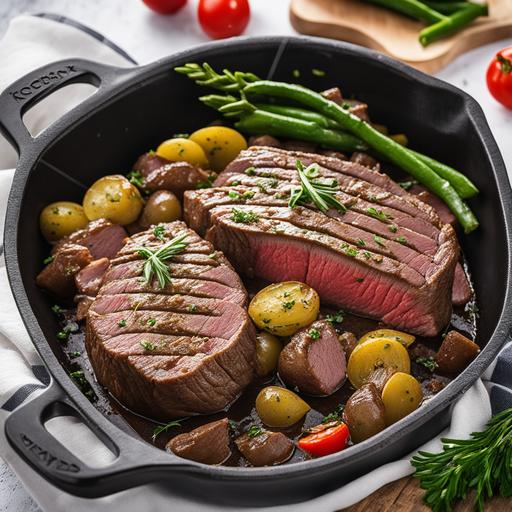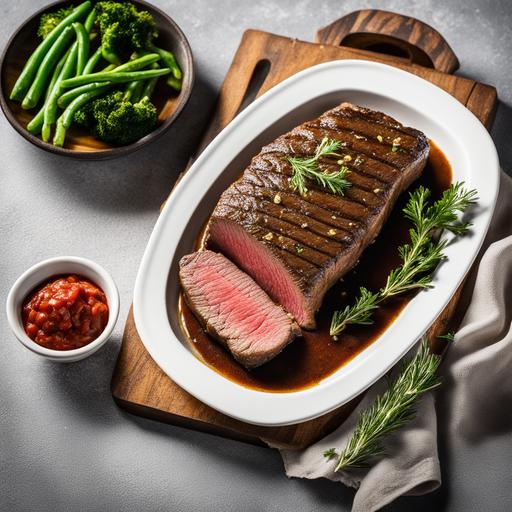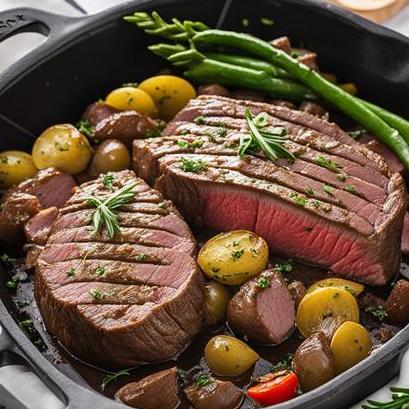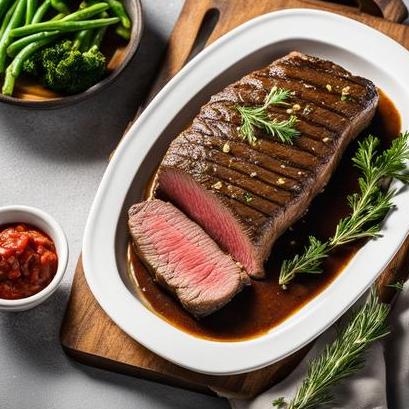
Beef Top Round Steak Oven Recipe: A Delicious And Nutritious Culinary Adventure
Have you ever been in a culinary dilemma, unsure of how to transform a simple top round steak into a mouthwatering masterpiece? Look no further! In this comprehensive article, we will explore the art of preparing a delectable beef top round steak using your trusty oven. From the intricate science behind its succulence to the culinary details that will make your taste buds dance, we leave no stone unturned. So, put on your chef’s hat and get ready for a culinary adventure!
Understanding the Science: The Beauty of Top Round Steak
Before diving into the intricate details of preparing the perfect top round steak, let’s take a moment to appreciate the science behind the meat. Top round steak is a lean cut of beef, derived from the large leg muscle of a cow. Due to its low fat content, it requires careful cooking to maintain its tenderness and juiciness.
Culinary Details: Selecting the Perfect Cut
When it comes to selecting the ideal top round steak, there are a few key factors to consider. Look for a steak with a deep red color, minimal visible fat, and even marbling. The marbling, thin ribbons of fat, will add moisture and flavor to your final dish.
Cleaning and Preparation: The Foundation of Success

Proper cleaning and preparation lay the foundation for a successful culinary adventure. Start by rinsing your top round steak under cold running water to remove any visible debris. Pat it dry with paper towels, ensuring there is no excess moisture left on the surface.
Maillard Reaction: Adding Flavor Through Browning
To achieve a mouthwatering crust and lock in juicy flavors, embrace the Maillard reaction. This chemical reaction occurs when protein-rich foods are exposed to high heat. Preheat your oven to a scorching 450°F (232°C), providing the perfect environment for this magical transformation to take place.
Dry Rubs and Marinades: Enhancing the Flavor Profile

To infuse your beef top round steak with an explosion of flavors, consider using dry rubs or marinades. Dry rubs, a blend of spices and herbs, can be rubbed onto the steak before cooking. Marinades, on the other hand, consist of a liquid mixture that the steak soaks in for an extended period, allowing the flavors to penetrate the meat. Get creative and experiment with various seasonings, herbs, and liquids to suit your preferences.
Oven Cooking: The Perfect Technique
Now, it’s time to embark on the magical journey of oven cooking! Follow these steps diligently to ensure the perfect beef top round steak:
Step 1: Preheating the Oven
Preheat your oven to 450°F (232°C) and ensure it reaches the desired temperature before placing the steak inside.
Step 2: Searing the Steak
Heat a cast-iron skillet on medium-high heat and add a tablespoon of vegetable oil. Once the oil begins to shimmer, place the steak in the skillet to sear for 4-5 minutes on each side. This initial sear will lock in the steak’s juices and create a flavorful crust.
Step 3: Moving to the Oven
Remove the seared steak from the skillet and transfer it to a wire rack placed on a baking sheet. This allows the hot air to circulate evenly, ensuring a beautiful, even cook.
Step 4: Roasting to Perfection
Place the baking sheet with the steak into the preheated oven. For medium-rare, cook the top round steak for 20-25 minutes until the internal temperature reaches 135°F (57°C). Adjust the cooking time according to your desired level of doneness. Remember, the oven is your culinary canvas; feel free to experiment and explore as you hone your skills.
Step 5: Resting Period
Once the beef top round steak reaches your desired doneness, remove it from the oven and let it rest for 5-10 minutes. This resting period allows the juices to redistribute throughout the meat, resulting in a tender and succulent steak.
Doneness Checks: Ensuring Perfect Cookedness

An overcooked or undercooked steak can mar your culinary masterpiece. Fortunately, several techniques can help you check the doneness of your top round steak:
Using a Meat Thermometer: Insert a meat thermometer into the thickest part of the steak to measure its internal temperature accurately. For medium-rare, aim for 135°F (57°C).
Touch Test: Using your index finger and thumb, compare the firmness of the meat to different parts of your hand. A medium-rare steak should feel similar to the fleshy part of your palm below the thumb.
By using these methods, you can take the guesswork out of achieving perfect doneness every time!
Tips and Variations: Your Creativity Unleashed
Cooking is an art, and as an artist, feel free to experiment and customize the recipe to suit your taste buds. Here are some tips and variations to spark your creativity:
Tenderize with a Marinade: Marinate your top round steak overnight to impart tenderness and enhance the flavors. Experiment with different combinations of acidic liquids, such as citrus juices or vinegar, to break down the meat’s proteins.
Herb Butter Basting: Elevate your steak by basting it with herb-infused butter during the roasting process. Melt butter in a pan, add your favorite herbs, and brush it onto the steak every few minutes.
Serving Suggestions: Pair your succulent beef top round steak with creamy mashed potatoes, roasted vegetables, or a fresh salad for a complete and balanced meal.
The Risk of Overcooking: Preventing Culinary Tragedy

While the quest for perfection is admirable, there is a fine line between a perfectly cooked steak and an overcooked disaster. Overcooking can result in a dry and tough piece of meat. To prevent this culinary tragedy, it’s essential to monitor the steak’s internal temperature and follow the recommended cooking times.
Remember, practice makes perfect. Don’t be discouraged if your first attempt falls short; learn from the experience and apply the knowledge gained to your next culinary adventure.
The Art of Undercooking: A Delicate Balance
Similarly, undercooking your beef top round steak can leave it raw and cold in the center. While some people prefer this rare delicacy, it is crucial to ensure the meat reaches a safe internal temperature to prevent potential health risks. Follow the doneness checks and recommendations provided earlier to ensure a perfect balance between succulence and safety.
A Delicious Culinary Journey Awaits!
Congratulations! Armed with this comprehensive guide, you are now well-equipped to embark on a culinary adventure centered around a delectable beef top round steak. From the scientific marvels to the intricate preparation details and mouthwatering variations, you have all you need to create a masterpiece that will impress family and friends. So, put on your apron, preheat your oven, and let the aromatic symphony of flavors and textures awaken your senses. After all, cooking is not only about nourishing the body but also about indulging in the joys of creative expression. Enjoy the journey and savor every bite!
Sources
FAQS On Beef Top Round Steak Oven Recipe
What Is The Oven Temperature And Cook Time For Beef Top Round Steak?
Preheat the oven to 375 degrees Fahrenheit and cook the steak for 15-20 minutes per pound.
How Do I Know When The Steak Is Done Cooking?
Use a meat thermometer to check the internal temperature. For medium rare, the steak should reach 145 degrees Fahrenheit.
Can I Marinate The Beef Before Cooking?
Yes, marinating the beef top round steak for at least 2 hours will help tenderize the meat and add flavor.
What Type Of Seasoning Should I Use For This Recipe?
You can use a variety of seasonings such as garlic, herbs, and spices. A simple mixture of salt, pepper, and olive oil will also suffice.
Do I Need To Let The Steak Rest Before Slicing?
Yes, it is recommended to let the steak rest for 5-10 minutes before slicing. This allows the juices to redistribute and keeps the meat tender and juicy.


